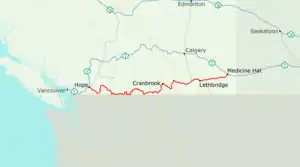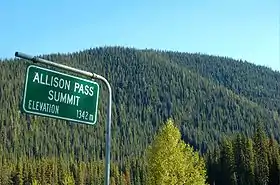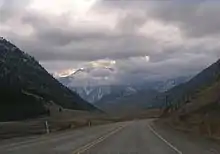Crowsnest Highway
The Crowsnest Highway is an east-west highway in British Columbia and Alberta, Canada. It stretches 1,161 km (721 mi) across the southern portions of both provinces, from Hope, British Columbia to Medicine Hat, Alberta, providing the shortest highway connection between the Lower Mainland and southeast Alberta through the Canadian Rockies. Mostly two-lane, the highway was officially designated in 1932, mainly following a mid-19th-century gold rush trail originally traced out by an engineer named Edgar Dewdney. It takes its name from the Crowsnest Pass, the location at which the highway crosses the Continental Divide between British Columbia and Alberta.
Crowsnest Highway | |
|---|---|
| Highway 3 | |
 The Crowsnest Highway highlighted in red | |
| Route information | |
| Length | 1,161 km (721 mi) |
| Existed | 1932–present |
| Component highways | BC 3, AB 3 |
| Major junctions | |
| West end | |
| East end | |
| Location | |
| Country | Canada |
| Provinces | British Columbia, Alberta |
| Highway system | |
|
| |
| National Highway System | |
In British Columbia, the highway is entirely in mountainous regions and is also known as the Southern Trans-Provincial Highway. The first segment between the Trans-Canada Highway and Highway 5A is locally known as the Hope-Princeton Highway, and passes by the site of the Hope Slide. In Alberta, the terrain is initially mountainous, before smoothing to foothills and eventually generally flat prairie in the vicinity of Pincher Creek. The highway forms part of the Red Coat Trail and the CANAMEX Corridor from Highway 2 near Fort Macleod to Highway 4 in Lethbridge. Many sections of the highway was built by Japanese labour while they were interned during the Second World War, including sections like the Hope-Princeton. This history has been preserved at a heritage marker at Sunshine Valley, which was the largest internment camp in Canada.
Route description
Crowsnest Highway is designated a core route in Canada's National Highway System, and is designated as Highway 3 for its entire length.[1]
British Columbia

The Crowsnest Highway's western terminus is at Hope, where it branches off from the Trans-Canada Highway (Highway 1). The highway goes east for 7 km (4 mi) to its junction with the Coquihalla Highway (Highway 5), where it exits the freeway and continues for 127 km (79 mi) on a segment known as the Hope-Princeton Highway, passing the Hope Slide en route to Allison Pass, Manning Provincial Park, and Sunday Summit; at Princeton, the Crowsnest Highway meets Highway 5A.[2] East of Princeton, the Crowsnest Highway goes southeast for 67 km (42 mi) to Keremeos, where it meets Highway 3A, leading towards Penticton and Highway 97. Another 46 km (29 mi) southeast, and the Crowsnest Highway reaches Osoyoos and a junction with Highway 97.

.jpg.webp)
Approximately 52 km (32 mi) east of Osoyoos, the Crowsnest Highway reaches its junction with Highway 33 at Rock Creek, then the highway heads east for 70 km (43 mi) to its junction with Highway 41, just before passing through Grand Forks. Another 26 km (16 mi) east, the Crowsnest Highway meets Highway 395 at the southern end of Christina Lake.[2] The Crowsnest Highway travels for 47 km (29 mi) through Bonanza Pass to its junction with Highway 3B at Nancy Greene Lake, which is the cutoff to Rossland and Trail. It is another 26 km (16 mi) east to Castlegar, where the Crowsnest Highway intersects Highway 22 and Highway 3A, leading towards Nelson. Approximately 26 km (16 mi) east of Castlegar, the Crowsnest Highway reaches its eastern junction with Highway 3B; another 11 km (6.8 mi) to the east it converges with Highway 6 at Salmo and the two highways share a concurrency for 14 km (9 mi) to Burnt Flat.[2]
The Crowsnest Highway continues through the Kootenay Pass on the Salmo-Creston Highway, a stretch known colloquially as the Kootenay Skyway, or Salmo-Creston Skyway. 67 km (42 mi) east of Burnt Flat, the Crowsnest Highway reaches Creston, just past junctions with Highway 21 and Highway 3A. 40 km (25 mi) later, south of Yahk, Highway 95 merges onto the Crowsnest Highway. The two highways share a common alignment for 72 km (45 mi) northeast to Cranbrook and the junction with Highway 95A. Another 6 km (4 mi) east, Highway 95 diverges north while Highway 93 merges onto the Crowsnest Highway from a shared alignment. Highway 93 and the Crowsnest share a common alignment for the next 53 km (33 mi) southeast to Elko, where Highway 93 diverges south. 31 km (19 mi) northeast of Elko, the Crowsnest Highway reaches Fernie, then it goes north another 30 km (19 mi) to its junction with Highway 43 at Sparwood, and another 19 km (12 mi) east, the highway reaches the boundary with Alberta at Crowsnest Pass.[2]
Alberta

The Alberta portion of the Crowsnest Highway is also designated as Highway 3, running for approximately 323 km (201 mi) from the British Columbia border to Medicine Hat. It begins in Crowsnest Pass paralleling the Canadian Pacific Railway, first meeting Highway 40 at Coleman, then running 26 km (16 mi) east to the southern terminus of Highway 22. Highway 6 splits south near Pincher Creek. Approximately 50 km (31 mi) east of Pincher Creek, the highway becomes divided and interchanges with Highway 2 with which it is briefly concurrent, assuming the designation of the Red Coat Trail and CANAMEX Corridor. It proceeds for 5 km (3 mi) into the town of Fort Macleod, after which Highway 2 splits south to Cardston and the United States border. Highway 3 then crosses the Oldman River east of Fort Macleod near Monarch, prior to a partial interchange with Highway 23.[3]
After Coalhurst, the highway reaches Westview Drive W, which provides access to West Lethbridge. It then becomes a freeway named Crowsnest Trail as it reaches Highway 25 which branches north to Picture Butte while University Drive runs south to the University of Lethbridge as the main thoroughfare through West Lethbridge. Highway 3 again crosses the Oldman River in central Lethbridge and the freeway segment ends at Mayor Magrath Drive, marking the northern terminus of Highway 5. The highway meets the northern end of Highway 4 at the eastern limit of Lethbridge before continuing east to Coaldale and Taber.[3] Within Taber, Highway 36 runs concurrently with Highway 3 for 3 km (2 mi). The highway reduces to a two-lane undivided road and the Crowsnest Highway ends 113 km (70 mi) later at the Trans-Canada Highway in Medicine Hat.
Future
Alberta Transportation has long-term plans to upgrade the entire Highway 3 corridor to a freeway from the British Columbia border to Medicine Hat.[4][5] The plans include the construction of a Lethbridge bypass to render the CANAMEX Corridor free-flowing through southern Alberta, in combination with proposed bypasses of Fort Macleod, Claresholm and Nanton.[6][7] The route would split from Highway 3 west of Coalhurst and run east, bypassing Lethbridge and Coaldale to the north before rejoining the existing highway.[7]
During the 2021 British Columbia floods, the Crowsnest Highway was closed by landslides, as were the other routes connecting the Lower Mainland with the rest of Canada. It was the first of these routes to reopen.[8] During the period when it was the only road route between Metro Vancouver and the rest of Canada, it experienced a high rate of crashes among heavy trucks driving faster than the route's windy curves would allow for.[9]
Major intersections
The following is a list of major intersections along the Crowsnest Highway:[2][10][6][11]
| Province | Location | km | mi | Destinations | Notes |
|---|---|---|---|---|---|
| British Columbia | Hope | 0.0 | 0.0 | West end of Hwy 5 concurrency; exit 170 | |
| | 6.7 | 4.2 | East end of Hwy 5 concurrency; exit 177 | ||
| Princeton | 133.9 | 83.2 | |||
| Keremeos | 201.1 | 125.0 | |||
| Osoyoos | 247.1 | 153.5 | |||
| Rock Creek | 299.1 | 185.9 | |||
| near Grand Forks | 368.5 | 229.0 | |||
| near Christina Lake | 392.1 | 243.6 | |||
| | 441.5 | 274.3 | |||
| Castlegar | 467.9 | 290.7 | |||
| 469.2 | 291.5 | ||||
| | 495.7 | 308.0 | |||
| Salmo | 506.1 | 314.5 | West end of Hwy 6 concurrency | ||
| | 520.2 | 323.2 | East end of Hwy 6 concurrency | ||
| Creston | 585.1 | 363.6 | |||
| 586.5 | 364.4 | ||||
| Yahk | 626.6 | 389.4 | West end of Hwy 95 concurrency | ||
| Cranbrook | 698.9 | 434.3 | |||
| | 704.3 | 437.6 | East end of Hwy 95 concurrency; west end of Hwy 93 concurrency | ||
| Elko | 760.1 | 472.3 | West end of Hwy 93 concurrency | ||
| Sparwood | 821.9 | 510.7 | |||
| Alberta – British Columbia border | 841.3 | 522.8 | Crowsnest Pass (Continental Divide) | ||
| Alberta | Crowsnest Pass | 856.9 | 532.5 | ||
| near Lundbreck | 883.1 | 548.7 | |||
| | 903.2 | 561.2 | |||
| Fort Macleod | 946.7 | 588.3 | West end of Hwy 2 concurrency | ||
| 951.9 | 591.5 | East end of Hwy 2 concurrency; Red Coat Trail western terminus | |||
| | 973.1 | 604.7 | Eastbound access to Hwy 23 | ||
| Monarch | 978.4 | 607.9 | Westbound exit, eastbound entrance | ||
| Lethbridge | 994.4 | 617.9 | |||
| 997.6 | 619.9 | East end of Red Coat Trail concurrency | |||
| 1,000.7 | 621.8 | ||||
| 1,003.1 | 623.3 | ||||
| Taber | 1,049.9 | 652.4 | West end of Hwy 36 concurrency | ||
| 1,052.5 | 654.0 | East end of Hwy 36 concurrency | |||
| Medicine Hat | 1,165.3 | 724.1 | |||
1.000 mi = 1.609 km; 1.000 km = 0.621 mi
| |||||
See also
- CANAMEX Corridor
- Dewdney Trail
- Kettle Valley Railway (southern mainline of the CPR)
- Pan-American Highway
- Red Coat Trail
- Yellowhead Highway
References
- "National Highway System". Transport Canada. December 13, 2009. Retrieved March 16, 2011.
- Official British Columbia Road Map and Parks Guide (Map). 1:463,600. Victoria, BC: Davenport Maps Ltd. 2016. §§ L-9, L-10, L-11, L-12.
- Google (October 31, 2016). "Crownest Highway in Alberta" (Map). Google Maps. Google. Retrieved October 31, 2016.
- "Highways 1 & 3 Network Functional Planning Study - Future Realignment - City of Medicine Hat - Executive Summary" (PDF). Stantec. Alberta Transportation. November 20, 2008. p. 5. Retrieved January 23, 2017.
...Alberta Transportation strives for a higher standard of roadway, and therefore seeks to protect the future Highways 1 and 3 for a 130 km/h design speed (110 km/h posted speed).
- "Highway 3:14 Functional Planning Study - West of Burdett to West of Seven Persons" (PDF). ISL Engineering and Land Services. Alberta Transportation. June 2013. p. 1. Archived (PDF) from the original on January 23, 2017. Retrieved January 23, 2017.
In the mid-2000s, Alberta Transportation (AT) identified the entirety of Highway 3 as part of the newly-designated freeway system.
- "Provincial Highways 1 - 216 Progress Chart" (PDF). Alberta Transportation. March 2015. Retrieved 28 April 2016.
- "Highways 3 & 4 - Lethbridge and Area NHS & NTSC Functional Planning Study - Final Report" (PDF). Stantec Consulting Ltd. Alberta Transportation. February 2006. Retrieved October 28, 2016.
- "Major BC highway could reopen this weekend as new photos show huge damage along Coquihalla | News". dailyhive.com. Retrieved 2021-11-20.
- Britten, Liam (7 December 2021). "Drivers urged to slow down on Hwy 3 as crashes mount on critical route for freight trucks". CBC News.
- Nicol, Matthew; Horel, Steve (July 2015). "Landmark Kilometre Inventory" (PDF). British Columbia Ministry of Transportation and Infrastructure. Cypher Consulting. pp. 74–113. Archived from the original (PDF) on 2016-06-01. Retrieved 2016-07-05.
- Alberta Official Road Map (Map) (2010 ed.). Alberta Tourism, Parks and Recreation. § N-5, N–6, N-7, N–8.

.svg.png.webp)